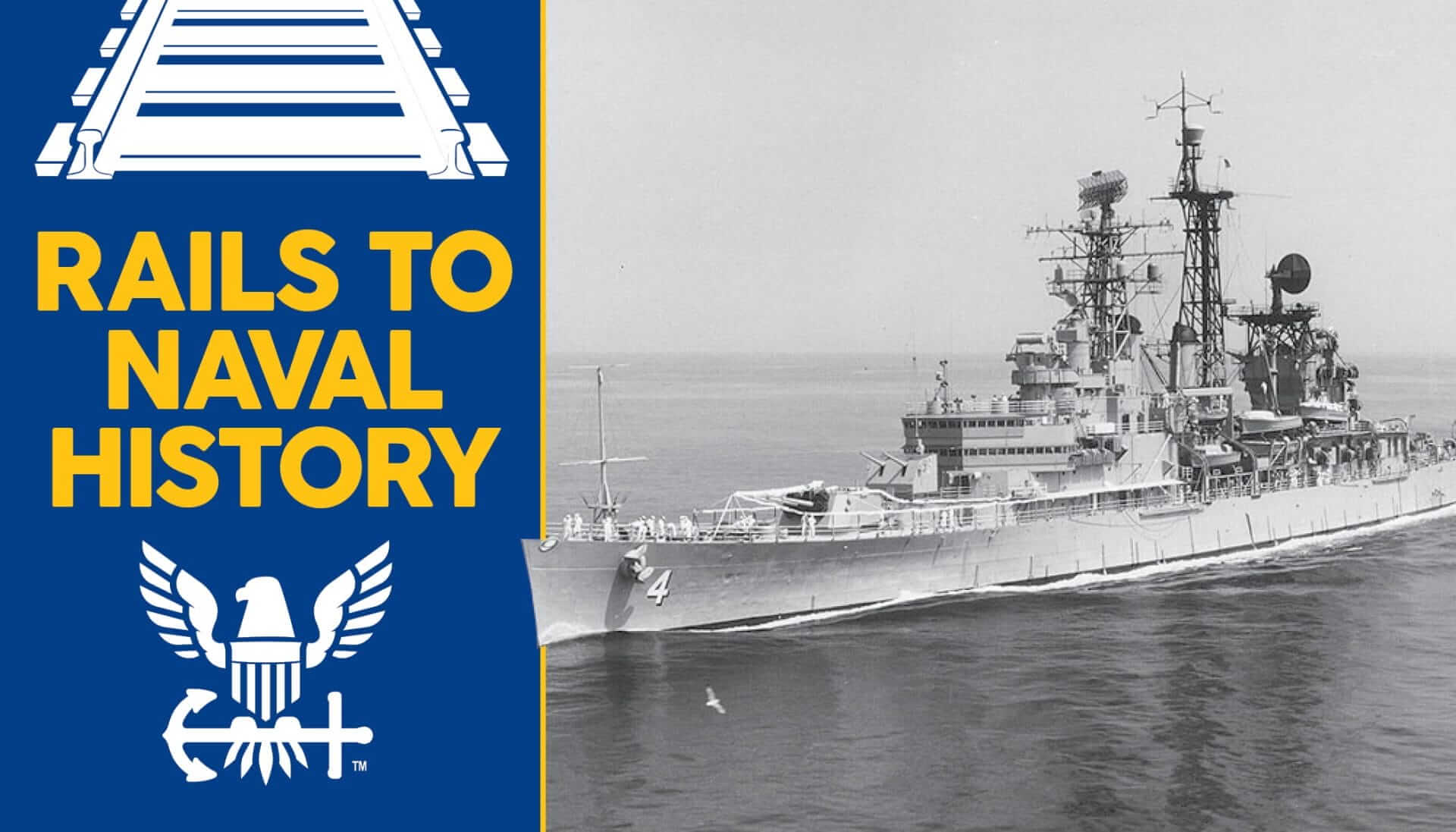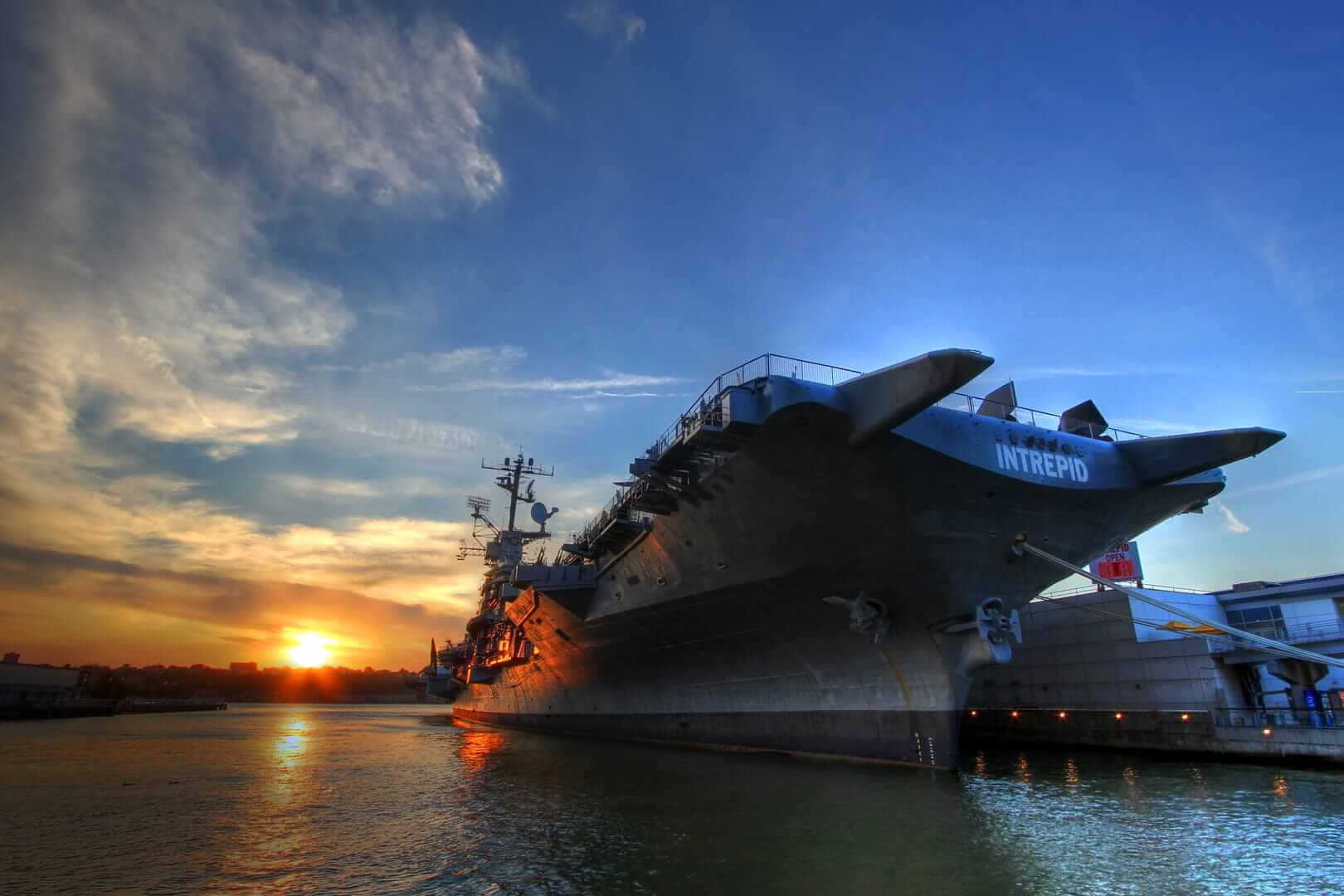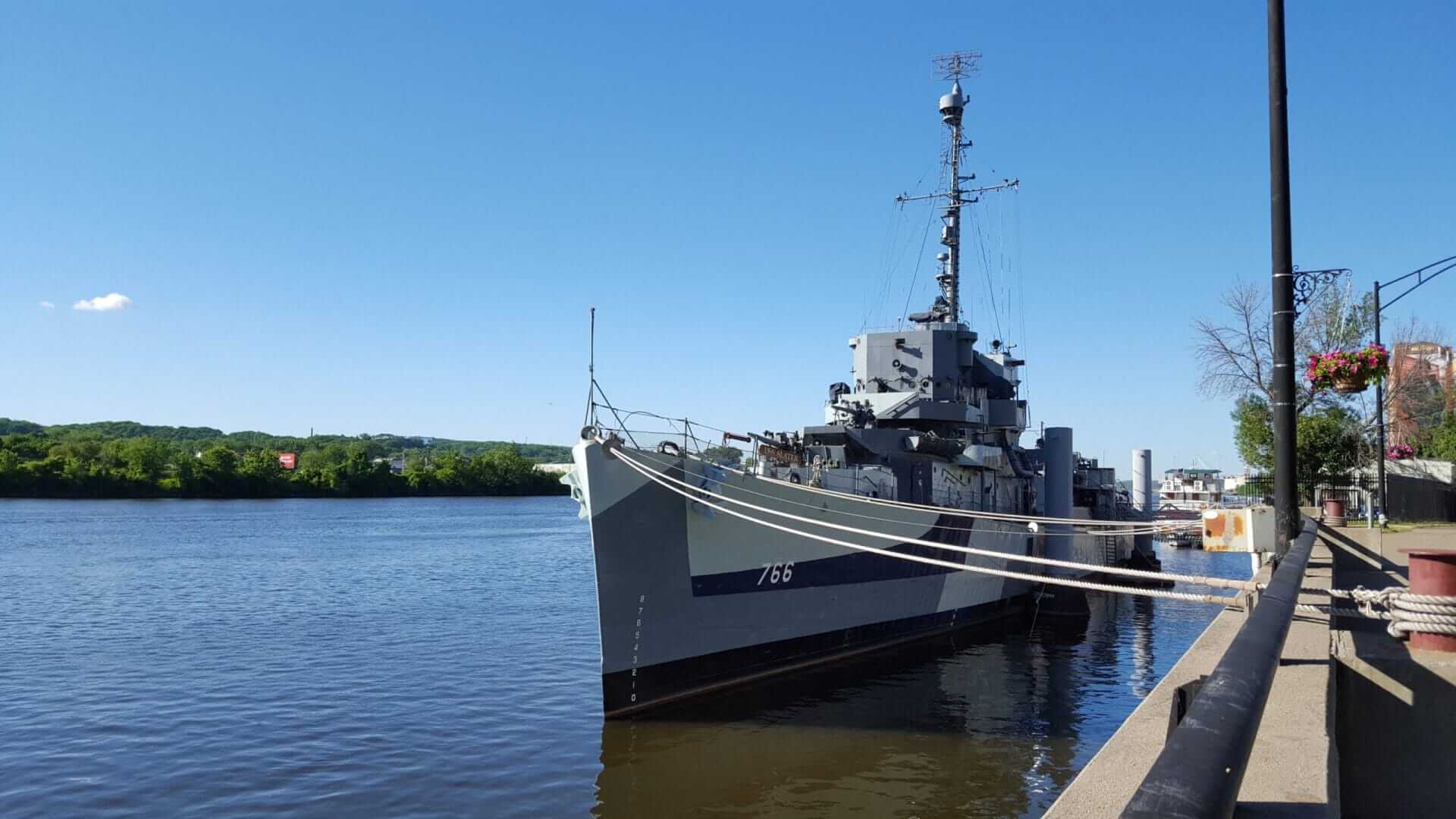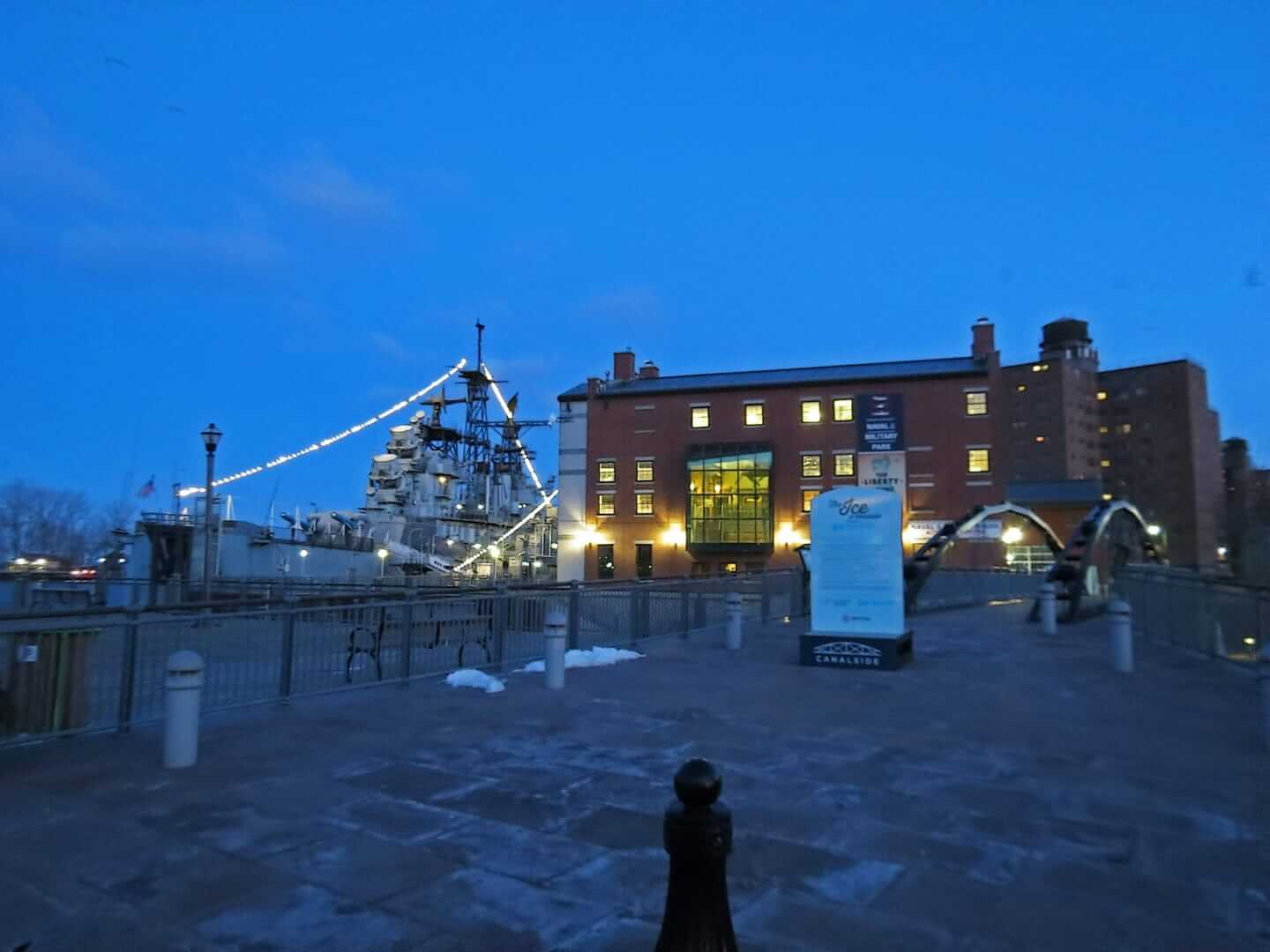Rails to Naval History

New York State has a rich naval history, from the battles fought on Lake Champlain and the Great Lakes during the Revolutionary War and War of 1812, to the Brooklyn Naval Yard where many great warships were built.
As a railfan and naval history buff, I’ve recently noticed that people who love trains often love ships and vice versa. Here in New York State, you can combine your love of trains and ships by taking Amtrak to visit three different historic navy ship museums in Manhattan, Albany and Buffalo.
Intrepid Sea, air & Space Museum

Pier 86, W 46th St, New York, NY 10036 | Distance From Moynihan Train Hall at Penn Station (NYP): 2.4 Miles
Getting There: Located on the West Side of Manhattan at Pier 86 at 46th Street along the Hudson River, the Intrepid is a 30-minute walk from both Grand Central Terminal and Penn Station.
The centerpiece of the museum is the aircraft carrier USS Intrepid, which includes a British Airways Concorde SST supersonic jetliner, a CIA Lockheed A-12 supersonic reconnaissance plane, the NASA Space Shuttle Enterprise, and the submarine USS Growler. Along with the South Street Seaport Museum in Lower Manhattan, the USS Intrepid is one of New York City’s two historic ship maritime museums.
The USS Intrepid (CV-11) was the fifth Essex-class aircraft carrier to be completed during WW2, the ship served in the Pacific till the end of the war, earning the nickname ‘The Fighting I.’ Her crew saw plenty of action as the ship was badly damaged in a torpedo attack by a Japanese aircraft in 1944.
In the early 1950s, the Intrepid was rebuilt into a modern attack carrier, being recommissioned in 1954. The carrier became the first to launch aircraft with American-built steam catapults, which allowed heavy jet fighters to be deployed effectively.
In the 1960s the Intrepid was the recovery ship for both the Mercury-Aurora 7 and a Gemini 3 manned space missions. The carrier also took part in three deployments during the Vietnam War. After an active career in 1974 the Intrepid was decommissioned for the final time, becoming a museum ship in 1982 at its current location.
The USS Growler (SSG-577) was an early cruise missile diesel-electric submarine of the Cold War that entered service in 1958. Based in part on the design of the aircraft carrying Japanese submarines of WW2, the Growler was designed to fire the land-attack SSM-N-8A Regulus turbojet cruise missile.
To fire one of the four large Regulus missiles, she carried in two hangers. Then, the sub would surface, pull a missile out of a forward hanger, mount it on a launching rail, and then fire at its target. The missiles could be fitted with either nuclear or conventional warheads.
For a brief period, the Growler was a small part of America’s nuclear deterrence, but as technology quickly outpaced the Regulus with the development of the Polaris ballistic missile that was fired from submerged submarines, the Growler was decommissioned in 1964.
After years of neglect, the Growler was saved from scrapping or being sunk as a practice target, joining the Intrepid Museum in 1988. Today you can visit her with a Regulus missile posed on the launcher.
At the museum, there are also many exciting exhibitions to explore. You won’t want to miss Postcards from Earth: Holograms on an Interstellar Journey, which is a temporary exhibit that showcases an inspiring collaboration between science and art. It investigates unique materials and approaches used to develop a vehicle capable of reaching another star system at speeds never thought to be achievable. On the Mend: Restoring Intrepid’s Sick Bay is another fascinating exhibition. It examines the history of medical care on the ship. Objects, photographs, archives and oral histories will be featured. Visitors can also explore an interactive 3D model of sick bay. Other current exhibitions include Kamikaze: Beyond the Fire, On the Line: Intrepid and the Vietnam War, and A View from the Deep: The Submarine Growler and the Cold War.
This August, you can look forward to the museum’s 80th anniversary. Open to the public, Intrepid’s 80th Commissioning Anniversary Celebration will feature events for former crew members and their families, as well as opportunities for members of the public to interact with those visiting former crew members.
NYC is the perfect day trip or getaway because of its many attractions and things to do. Nearby, you can walk the High Line, a repurposed rail trail, or visit attractions like SUMMIT One Vanderbilt, Edge at Hudson Yards, Little Island and RiseNY.
USS Slater: Destroyer Escort Historical Museum

141 Broadway, Albany, NY 12202 | Distance From Albany-Rensselaer Station (ALB): 2 Miles
Getting There: From the Rensselaer Rail Station, the Slater is a 30-minute walk across the Dunn Memorial Bridge. Also, CDTA bus and taxi/rideshare are available at the station.
Wars are not just won by the big battleships and aircraft carriers that typically gain control of the sea from enemy fleets. Wars are also fought with numerous small ships that helped to win during the famous battles. One such small ship was the USS Slater (DE-766), one of 563 anti-submarine destroyer escorts built during WW2 for the US Navy.
Commissioned in May 1944, the Slater is a Cannon-class destroyer escort, an anti-submarine escort ship. After seeing service in the Atlantic and Pacific during WW2, the ship was placed in reserve and then sold to Greece in 1951. Renamed the Aetos, she was decommissioned in 1991 and donated to the Destroyer Escort Sailors Association which brought her to Albany NY in 1997.
The Slater has been featured in three motion pictures, including the 1961 British-American action film ‘The Guns of Navarone,’ the 1961 Greek comedy ‘Alice in the Navy,’ and the 2008 Japanese war film ‘Last Operations Under the Orion’ from Japan, where a US Navy destroyer hunts a Japanese submarine in WW2.
Moored on the Hudson River in Albany, the Slater has undergone an extensive restoration by volunteers that has returned the ship to her former WW2 condition, placing her on the National Register of Historic Places.
In addition to the USS Slater, the Destroyer Escort Historical Museum also features exhibits, items, and collections. The museum is home to thousands of artifacts from destroyer escorts, donated by DE sailors and their families. Check out a Japanese army sword acquired following the surrender of Japanese forces, peruse a collection of items from the USS Stafford, view the Destroyer Escorts and the Battle of Samar exhibit, and much more!
As the Capital of New York State, Albany has plenty of unique places to explore. In downtown Albany, where the USS Slater is located, you can find the New York State Capitol, Empire State Plaza and the Albany Insitute of History and Art. To make your visit even easier, there is an abundance of hotels and restaurants throughout the city.
buffalo and erie county military park

1 Naval, Marina Park S, Buffalo, NY 14202 | Distance From Buffalo-Exchange Street Station (BFX): 0.3 Miles
Getting There: The museum is a short walk from Amtrak’s Buffalo Exchange Street Station. And, the NFTA Metro Rail along Main Street connects Canalside to the rest of downtown Buffalo.
Located on the waterfront in Buffalo’s Canalside District, the Buffalo and Erie County Naval & Military Park is the country’s largest inland Naval Park. Canalside is at the heart of downtown Buffalo’s waterfront revitalization and is the historic location of the terminus of the original 19th Century Erie Canal.
The museum has three preserved large warships – the USS Croaker, USS The Sullivans and USS Little Rock – docked beside the museum. There is a plethora of naval and military history exhibits, several aircrafts and vehicles, including the Nasty-class Fast Patrol Boat PTF-17, which saw service in Vietnam.
The USS Croaker (SSK-246) is a Gato-class diesel-electric submarine that served in WW2, undertaking combat patrols in the Pacific where she sank eight Japanese ships and as a “plane guard” rescued downed US pilots. In the 1950s she was extensively rebuilt as a Cold War hunter-killer submarine and served actively until decommissioning in 1968, becoming part of the museum in 1988.
USS The Sullivans (DD-537) is a WW2 Fletcher-class destroyer named in honor of the five Sullivan brothers – George, Francis, Joseph, Madison and Albert – who lost their lives when their ship was sunk during the Naval Battle of Guadalcanal in November 1942. The Sullivans saw service in both WW2 and the Korean War. They were decommissioned in 1965 and donated by the Navy to the museum in 1977.
The USS Little Rock (CG-4) with her massive superstructure and masts towers over both the submarine and the destroyer. One of 27 Cleveland-class light cruisers was completed for the US Navy during WW2, but she was too late to see service.
In the late 1950s, she was one of six WW2 big gun cruisers to be converted to guided missile ships, trading most of her guns for a large superstructure containing command, electronic, and the large magazine and assembly spaces required for the anti-aircraft Talos missile system.
After a Cold War career in the Atlantic and Mediterranean, the Little Rock was decommissioned in 1976 after her Talos missiles were declared obsolete. Donated to the museum, the missile cruiser was towed via the Saint Lawrence Seaway to Buffalo in 1977.
n addition to decommissioned naval vessels, the Buffalo Naval & Military Park also features a beautifully manicured Monuments Garden, Museum, and its Outdoor Exhibit Yard. The Monuments Garden is located in a green oasis along the waterfront. It is home to many monuments, including the Iraq-Afghanistan Monument, Vietnam Memorial, and Hispanic American Veterans Memorial. This space serves as a quiet place for remembrance and reflection. The Museum Building has hundreds of artifacts on display. Its exhibits focus on the history of Western New York during times of war. The Outdoor Exhibit Yard contains some of the largest military equipment in the collection, including aircraft, an army M-41 tank, and the PTF-17 boat.
Of the three Naval Historic Ship Museums in New York State, Buffalo’s is the most convenient for railroad passengers. The accessibility of the train makes it easier to visit the museum, as well as areas like the Albright-Knox Museum, the Richardson Olmsted Campus, the Keybank Center and Sahlen Field.



